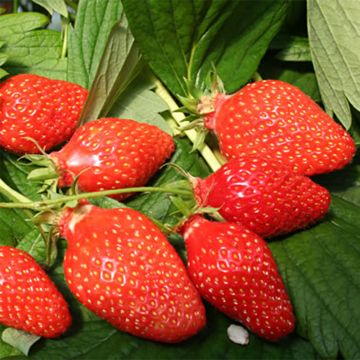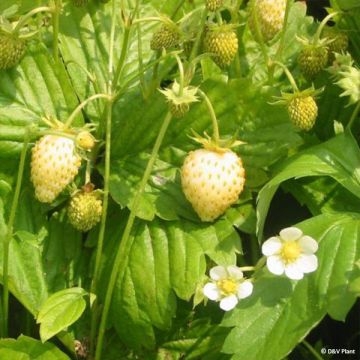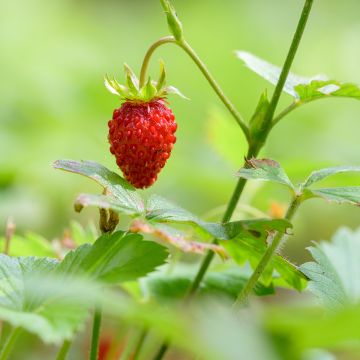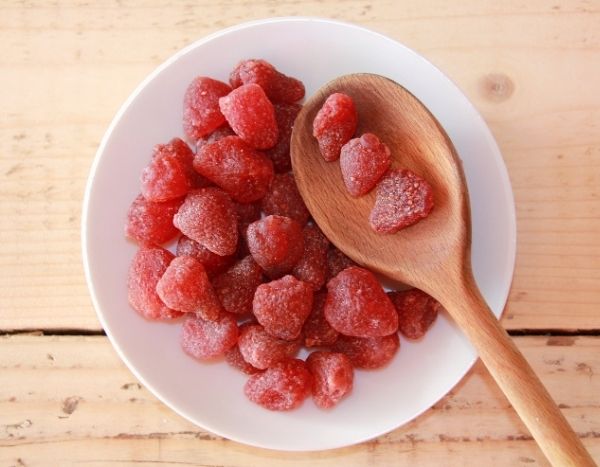

Strawberry Cijosée (everbearing) - Fragaria ananassa
Strawberry Cijosée (everbearing) - Fragaria ananassa
Fragaria ananassa Cijosée
Garden Strawberry, Pineapple Strawberry
Beaux plants déjà bien développés, même trop parce que j'ai eu du mal à les séparer. Les racines des 3 fraisiers avaient bien colonisés le pot et étaient très entremêlées.... Travail de séparation très délicat !
Catherine, 07/11/2022
Special offer!
Receive a €20 voucher for any order over €90 (excluding delivery costs, credit notes, and plastic-free options)!
1- Add your favorite plants to your cart.
2- Once you have reached €90, confirm your order (you can even choose the delivery date!).
3- As soon as your order is shipped, you will receive an email containing your voucher code, valid for 3 months (90 days).
Your voucher is unique and can only be used once, for any order with a minimum value of €20, excluding delivery costs.
Can be combined with other current offers, non-divisible and non-refundable.
Why not try an alternative variety in stock?
View all →This plant carries a 6 months recovery warranty
More information
We guarantee the quality of our plants for a full growing cycle, and will replace at our expense any plant that fails to recover under normal climatic and planting conditions.

Description
The Cijosée strawberry produces medium-sized, conical fruits, of good taste with a fine, juicy, and slightly acidic flesh. It is a perpetual variety that produces from June to October. Particularly hardy, it is a variety that can withstand temperatures of -15°C (5°F) and is therefore well-suited to the North and East of France as well as high altitudes. The Cijosée strawberries grow above the foliage, which makes harvesting easier; it easily produces runners, which is convenient for expanding your strawberry patch. It is resistant to Verticillium and has intermediate resistance to Phytophthora, Anthracnose, and Powdery Mildew.
Strawberries can be consumed in multiple ways: they can be eaten raw, with sugar, cream, or sliced thinly and dried before being added to muesli or yogurt. If you have a bountiful harvest, consider making jams, sauces, pies, ice cream, or sorbets. You can also freeze strawberries.
There are 3 categories of varieties:
- Wild strawberries or perpetual strawberries, producing small fruits from June to October
- Non-perpetual large fruit varieties, flowering once a year in spring, producing very large fruits around June
- Perpetual large fruit varieties, flowering twice a year or continuously, producing large fruits from June to October
In fact, the wild strawberry or woodland strawberry, present during Roman times and the medieval period, was crossed in the 18th century with a species brought back from Chile, resulting in, through successive selections, different large fruit varieties.
The Strawberry is a hardy perennial belonging to the Rosaceae family. This variety has a stout habit, with persistent, ovate, and dentate trifoliate leaves. It produces small white flowers with a golden center that transform into large red fruits. Botanically speaking, strawberries are considered pseudocarps, with the achenes (seeds) appearing on the surface of the skin.
For harvesting, pick the fruits as they ripen, every 2 or 3 days, ideally in the morning. Strawberries are delicate, so pick them with their calyx by pinching the stem 1 to 2 cm (0 to 1in) above it. The texture of the fruit is a good indicator of its ripeness. It should be firm and slightly yielding to the touch. Strawberries are rich in vitamins and minerals. They can cause skin irritation for some individuals as they stimulate the release of histamine in the body.
Strawberry Cijosée (everbearing) - Fragaria ananassa in pictures




Plant habit
Fruit
Flowering
Foliage
Botanical data
Fragaria
ananassa
Cijosée
Rosaceae
Garden Strawberry, Pineapple Strawberry
Cultivar or hybrid
Other Strawberry plants
View all →Planting and care
The Cijosée Strawberry appreciates rich, deep, and well-drained soils, slightly acidic. A few months before planting, loosen the soil and add a generous amount of well-rotted compost. If your soil is alkaline, add some turf and then provide a mulch made of acidic materials (pine needles or bark). Remove any weeds and rocks present in the soil. Planting this variety is preferably done in autumn. Choose a sunny location. Strawberry plants are good companions for garlic, beans, lettuce, onions, leeks, thyme, and spinach. However, they do not appreciate the company of cabbages and other brassicas. Strawberry plants remain in place for 3 to 4 years.
In the ground: Space the plants 35 cm (14in) apart in all directions. Dig a hole, place the strawberry plant (the collar should be level with the ground) and cover with fine soil. Water generously. If your soil is moist, plant the plants on mounds 10 to 20 cm (4 to 8in) high.
In a pot: Place a layer of gravel or clay balls at the bottom of the pot to facilitate drainage. Fill the pot with a mixture of potting soil, garden soil, and compost. Place the strawberry plant, cover with soil, and compact well. Water generously.
Regularly hoe the soil. Mulch around the plants in summer to maintain soil moisture. Install a protective net before the fruits turn red to avoid sharing your harvest with birds. You can also place ash or coffee grounds near the young plants to repel slugs and snails. Water regularly, especially in hot weather. In autumn, remove dry leaves.
Apply compost on the surface in spring. In cooler regions, install a tunnel in spring to protect the plants from spring frosts during flowering.
The plants need to be renewed every 3 or 4 years. This variety multiplies through adventive stems, small creeping stems that naturally root in the soil, forming new plants. To avoid exhausting the mother plant, cut the adventive stems and replant them if desired.
Wait for 4 years before replanting Strawberry plants in the same location.
Planting period
Intended location
Care
Planting & care advice
-
, onOrder confirmed
Reply from on Promesse de fleurs
Similar products
Haven't found what you were looking for?
Hardiness is the lowest winter temperature a plant can endure without suffering serious damage or even dying. However, hardiness is affected by location (a sheltered area, such as a patio), protection (winter cover) and soil type (hardiness is improved by well-drained soil).

Photo Sharing Terms & Conditions
In order to encourage gardeners to interact and share their experiences, Promesse de fleurs offers various media enabling content to be uploaded onto its Site - in particular via the ‘Photo sharing’ module.
The User agrees to refrain from:
- Posting any content that is illegal, prejudicial, insulting, racist, inciteful to hatred, revisionist, contrary to public decency, that infringes on privacy or on the privacy rights of third parties, in particular the publicity rights of persons and goods, intellectual property rights, or the right to privacy.
- Submitting content on behalf of a third party;
- Impersonate the identity of a third party and/or publish any personal information about a third party;
In general, the User undertakes to refrain from any unethical behaviour.
All Content (in particular text, comments, files, images, photos, videos, creative works, etc.), which may be subject to property or intellectual property rights, image or other private rights, shall remain the property of the User, subject to the limited rights granted by the terms of the licence granted by Promesse de fleurs as stated below. Users are at liberty to publish or not to publish such Content on the Site, notably via the ‘Photo Sharing’ facility, and accept that this Content shall be made public and freely accessible, notably on the Internet.
Users further acknowledge, undertake to have ,and guarantee that they hold all necessary rights and permissions to publish such material on the Site, in particular with regard to the legislation in force pertaining to any privacy, property, intellectual property, image, or contractual rights, or rights of any other nature. By publishing such Content on the Site, Users acknowledge accepting full liability as publishers of the Content within the meaning of the law, and grant Promesse de fleurs, free of charge, an inclusive, worldwide licence for the said Content for the entire duration of its publication, including all reproduction, representation, up/downloading, displaying, performing, transmission, and storage rights.
Users also grant permission for their name to be linked to the Content and accept that this link may not always be made available.
By engaging in posting material, Users consent to their Content becoming automatically accessible on the Internet, in particular on other sites and/or blogs and/or web pages of the Promesse de fleurs site, including in particular social pages and the Promesse de fleurs catalogue.
Users may secure the removal of entrusted content free of charge by issuing a simple request via our contact form.
The flowering period indicated on our website applies to countries and regions located in USDA zone 8 (France, the United Kingdom, Ireland, the Netherlands, etc.)
It will vary according to where you live:
- In zones 9 to 10 (Italy, Spain, Greece, etc.), flowering will occur about 2 to 4 weeks earlier.
- In zones 6 to 7 (Germany, Poland, Slovenia, and lower mountainous regions), flowering will be delayed by 2 to 3 weeks.
- In zone 5 (Central Europe, Scandinavia), blooming will be delayed by 3 to 5 weeks.
In temperate climates, pruning of spring-flowering shrubs (forsythia, spireas, etc.) should be done just after flowering.
Pruning of summer-flowering shrubs (Indian Lilac, Perovskia, etc.) can be done in winter or spring.
In cold regions as well as with frost-sensitive plants, avoid pruning too early when severe frosts may still occur.
The planting period indicated on our website applies to countries and regions located in USDA zone 8 (France, United Kingdom, Ireland, Netherlands).
It will vary according to where you live:
- In Mediterranean zones (Marseille, Madrid, Milan, etc.), autumn and winter are the best planting periods.
- In continental zones (Strasbourg, Munich, Vienna, etc.), delay planting by 2 to 3 weeks in spring and bring it forward by 2 to 4 weeks in autumn.
- In mountainous regions (the Alps, Pyrenees, Carpathians, etc.), it is best to plant in late spring (May-June) or late summer (August-September).
The harvesting period indicated on our website applies to countries and regions in USDA zone 8 (France, England, Ireland, the Netherlands).
In colder areas (Scandinavia, Poland, Austria...) fruit and vegetable harvests are likely to be delayed by 3-4 weeks.
In warmer areas (Italy, Spain, Greece, etc.), harvesting will probably take place earlier, depending on weather conditions.
The sowing periods indicated on our website apply to countries and regions within USDA Zone 8 (France, UK, Ireland, Netherlands).
In colder areas (Scandinavia, Poland, Austria...), delay any outdoor sowing by 3-4 weeks, or sow under glass.
In warmer climes (Italy, Spain, Greece, etc.), bring outdoor sowing forward by a few weeks.































































